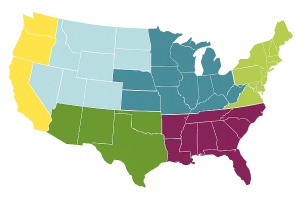Tips For When Your Perennials & Bulbs Arrive
Posted By American Meadows Content Team on Sep 27, 2012 · Revised on Oct 28, 2025

Knowing your location helps us recommend plants that will thrive in your climate, based on your Growing Zone.
Posted By American Meadows Content Team on Sep 27, 2012 · Revised on Oct 28, 2025
We’re here to help! Here are a few steps you can take to help your plants get established quickly so that they can grow to their full potential.

Potted plants will arrive in varying stages of growth, depending on the plant and the time of year.

Healthy bulbs are firm without any soft or mushy spots. Some surface mold is natural and won’t affect growth.

Bareroot plants may look a bit lifeless, but there will be no transplant shock, so they grow vigorously once in the ground.
Potted Plants
Bareroot Plants
See our perennial planting guides for more detailed planting information.
Fall-Planted Bulbs
See our fall-planted bulb guides for more detailed planting information.
Spring-Planted Bulbs
See our spring-planted bulb guides for more detailed planting information.
Not ready to dig in?

Carefully remove the plant from its pot by holding one hand over the soil and tapping the bottom of the pot. Squeezing the pot can help loosen the root ball from the pot. Don't pull on the plant or you may damage the stem. Rough the roots a little to encourage their spread. Place the root ball into the planting hole, doublechecking to be sure that the top of the root ball is even with the soil surface. Then backfill the hole with soil, gently firming it as you go.
Water thoroughly after planting, and continue to water at least every two weeks, depending on rainfall.

Bareroot plants arrive in a dormant state, ready to grow once they're planted.

Before setting plants out, be sure the spots you've chosen are good for the perennials you're planting. If you have questions about whether your plants demand full sun or can withstand partial shade, how tall the plant will grow, or other details, please consult the planting information on each product page on our website. (Search the name of the plant in the search box at the top of this page!)
For example, if you're planting bareroot peonies, remember peonies mature into large plants and like rich soil, so be sure the soil is rich and deep for each one. Or, if you're planting yarrow or lavender, remember these plants absolutely have to have drier conditions in wide, open full sun.
Of course, you can invest a lot of hard work in changing the character of the soil in your garden, adding compost to make the soil richer, or adding sand or gravel to make it drain more quickly. However, when you choose the right plants for your soil, the soil you have will probably be fine!
Every perennial garden has areas that vary in conditions. For example, you may have areas in your garden that are rich deep soil with good, but not quick, drainage; these are the spots with rich, dark soil that is almost always moist. Plants like daylilies and astilbes love these spots. Then there are usually the hot, dry spots. Maybe the soil is more gravelly here, and the area is a little raised, so drainage is extra-sharp, and the whole area is in the hot, baking sun all summer. Plants like yarrows, lavenders, and coneflowers are very happy here.
The groups below make good companion plants, since each group enjoys the same basic garden conditions. Of course, consider these groupings "rules of thumb," since there are no hard and fast rules. Also, many plants are adaptable and appear in more than one group.
Some perennials do best in rich soil, with plenty of moisture throughout the season. These are the classic perennial plants that enjoy "good garden soil."


Some perennials demand more arid conditions, with quick-draining loose soil and full sun all season long. Many of these plants are originally from prairie or desert-like areas, so need dry conditions.
Most of these perennials can withstand full sun, but also do well in areas that are shaded part of the day.


Perennials generally need water at least every two weeks, so if rain doesn't supply it, it's up to you. In the first season, perennials may need supplemental water to establish healthy roots.
It's generally best to water deeply, and less frequently, rather than watering lightly and often; this helps perennials establish deep and resilient roots.
As your plants grow, you'll get to know their characteristics. There's no secret to all this — just observe them closely. If you see good growth, it usually means that the plant is happy in the spot you chose for it, and your watering is about right. On the other hand, if certain plants stubbornly sit there and do nothing, or even worse, seem to start withering away, you need to take action.
A dryland plant like Yarrow or Lavender will begin suffering quickly if you're watering it too much. And likewise, moisture-lovers like daylilies or spiderworts will begin withering the same way if they're not getting the water they need. When you see this happening, you have two choices: Either adjust the watering for the plants that are showing stress, or dig up the whole plant with plenty of soil and move it to a new spot that's more to its liking. If you do that when your perennials are young, it's almost no work, and it can improve your success with the plant over the years to come.